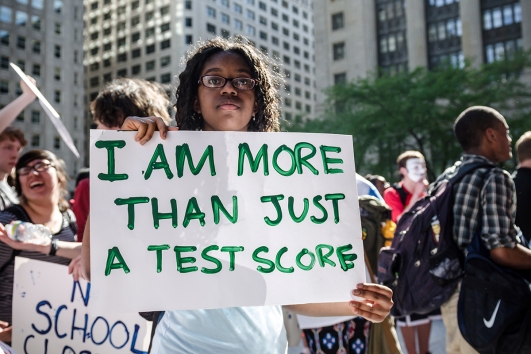
The high school student activists continued their march this week, appearing on a CNN town hall event, meeting with the President, and shepherding grassroots protests all over the nation, including two school walkouts in Arizona.
I continue to be inspired by this movement. More than anything, it’s causing me to further question the power dynamics at work in our schools.
Look at what’s going on. A random group of high school students — two weeks ago, they were being told what to read and turn in, and they had to ask permission to use the bathroom.
Two weeks ago, out of sheer boredom and a need for adventure or risk — anything different, really — teenagers were eating tide pods.
Now they’re fundraising, organizing, and mass-communicating. They are directing a movement that’s changing the national conversation and could potentially alter the entire political landscape.
What’s going on here?
They’ve got purpose. They’ve got autonomy. They’ve got responsibility.
Everyone in our society, and especially teachers or those in a position of power in education, should stop and think about the implications of this movement.
I want to reflect on two examples I’ve personally noticed.
A moment of freedom in class
The day after the shooting, I wanted to give my students space to talk and decompress and just chill with each other for a little bit. One day I gave them the option of making uplifting posters for our classroom with messages of love, belonging, and peace. Another day I invited them to write a short opinion piece about possible solutions to gun violence, email it to a PBS newscaster soliciting student input.
This is the scene I witnessed on Wednesday:
~Two students decided to write their opinion together. They spent the entire period discussing solutions, writing, looking up evidence to back up their opinion.
~One student decided to write it alone, interrupting himself only a few times to ask a question or chime in on a neighboring discussion.
~Five students got into a group and started discussing the differences between types of weapons, which is relevant in making any kind of ban. A wide-ranging and passionate discussion followed, which, by the end, had somehow morphed into a discussion about the differences between “sex” and “gender.”
~Two students decided to write a letter directly to the high schoolers in Florida. It was heartfelt and, in the words of one of the writers who seemed pleasantly surprised by the outcome, “poetic.”
~Four students sat together and seemed to be goofing around on Snapchat. Ordinarily I would have intervened, but on this day I let it slide. By the halfway point in the period, on their own volition, they started to write their opinions.
My takeaway: Students are perfectly capable of regulating themselves. They probably would get ten times as much from their education if they were allowed drastically more freedom and were not confined by the type, or even topic, of learning.
Two days on a bus with students
On Thursday I went on a field trip, an overnight trip to New Mexico to visit a few colleges.
The experience reminded me of how different the interactions can be with students outside the power structures of the classroom. All of a sudden, you see a different side of the students. The human side.
A teacher easily forgets that the classroom is an artificial and authoritarian power structure. You are in charge, the student is subordinate and must obey your orders out of threat of punishment. You dictate something of great importance — the grade, an official record that will help determine the future of this young person.
When you get to know a student outside of those walls, everything changes. A quiet student comes to life and starts cracking jokes. A defiant student starts to ask about your life. You learn that a student who struggled to concentrate in history class loves photography and has already started her own business.
My takeaway: We need to create more unstructured time within our educational institutions. We need to connect with each other on a more human level. Learning cannot be confined to what’s measured on a standardized test.
***
Some final thoughts.
Should these Florida students go back into their classrooms and take the rest of their required courses? Is it in their best interest — or in the best interest of the country — to have them spending their time, 8am – 3pm, taking direct instruction from teachers? Or spending their evenings doing math problems or writing five-paragraph essays?
They are learning infinitely more right now than they ever have in their institutional education. About accounting and budgeting. About functions and levers in government. About effective communication. You name it.
And now high school students across the country are following suit, organizing their own marches and walkouts. It’s beautiful.
What if all students were suddenly liberated to go explore their own interests and learn on their own terms?
What if our education system was designed around purpose, passion, and creativity?